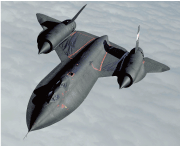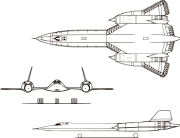E-Archive
Off the Beaten Track
in Vol. 21 - July Issue - Year 2020
Blackbird


The Soviet Union and the United States, the two superpowers emerging from the rubble of World War II, quickly went from being allies to becoming fierce competitors for political and economic dominance on the world stage. At the height of the Cold War, the capability to obtain detailed military intelligence became crucial, as each side suspected the other of preparing a surprise attack.
In the late 1950s, the most advanced American spy plane was the U-2. It could fly very high, but it was rather slow and it could be easily detected by enemy radar. In 1957 the Lockheed Corporation was asked to develop a new reconnaissance aircraft that could avoid detection and fly higher and faster than any existing military fighter and anti-aircraft missile. Work on the A-12, codenamed Oxcart, accelerated after a U-2 was shot down while flying over the Soviet Union in May 1960. The A-12 had its first test flights in April 1962 and immediately impressed with its greatly-superior performance. This single-seater aircraft soon evolved into the larger SR-71, which added a second seat for a reconnaissance systems officer. It was almost two meters longer than the A-12, allowing it to carry more fuel and more camera equipment. The SR-71 was codenamed Blackbird.
This new aircraft was in a completely different category than anything that had come before. Design and construction techniques had to be created from scratch. “Everything had to be invented, everything” recalled Kelly Johnson, Chief Designer at Lockheed. To begin with, the new aircraft was required to exceed a speed of 2,000 mph, or in the range of Mach 3. Other planes of the era could come close to that speed only by briefly activating their afterburners. The SR-71 was required to maintain this speed for hours at a time. The enormous friction with the atmosphere at such high speeds generated extremely high temperatures. In other types of aircraft, steel and aluminum alloys would be used for much of the aircraft frame and skin, with much more expensive titanium alloys used only for the surfaces exposed to the highest temperatures, such as the leading edges of wings and exhaust fairings. The temperature on the leading edges of the Blackbird’s wings was expected to exceed 1,000°F (538°C). Titanium alloys were the only option for 85% of the aircraft structure, with polymer composites making up the rest. Titanium proved to be a particularly sensitive material. It could shatter if mishandled. Lockheed was forced to come up with completely new production methods, and workers had to be retrained. It was discovered that welded titanium had to be washed with distilled water, since the chlorine in tap water is corrosive. Tools had to be redesigned and remanufactured with titanium, since the usual cadmium-plated steel tools embrittled the titanium on contact.
The extremely high temperatures generated on the Blackbird’s skin and frame in flight required special design and construction techniques. Most of the skin was corrugated, allowing it to expand vertically and horizontally as it heated up. A smooth skin would have split or curled. Fuselage panels were designed to fit loosely while the plane was on the ground, since correct alignment was achieved when the airframe heated up and expanded. The fuel tanks were deliberately designed to leak fuel before takeoff, becoming perfectly sealed once the airframe expanded in flight.
During a typical mission, the temperature on the aircraft’s external surface would exceed 500°F (260°C), whereas the inside of the windshield heated to 250°F (121°C). Upon landing, the temperature of the cockpit’s canopy would be over 570°F (300°C). Innovative solutions were devised to disperse these tremendous amounts of heat. Fuel was pumped as a coolant beneath the titanium surfaces. A heavy-duty air conditioning system discharged heat from the cockpits into the fuel prior to combustion. The crew was fitted with special pressurized suits that also provided oxygen at the extremely high altitudes reached by the SR-71.
Reducing the size of the aircraft’s radar image was another daunting challenge. The Blackbird was designed with flattened and tapering sides that deflected a radar’s beam rather than bouncing it back to its point of origin. The two rudders were tilted inwards. There was a pair of sharp edges called chines leading aft from either side of the nose along the fuselage. Tests proved that these measures succeeded in reducing the radar cross section by ninety percent.
The Blackbird could cruise at Mach 3.2, over 2,200 mph (3,540 km/h) and at altitudes up to 85,000 feet (26,000 m). Retired in 1990 and sixty years after its development, the Blackbird is still the world’s fastest and highest-flying air-breathing manned aircraft.
By Giovanni Gregorat, Contributing Editor MFN



























